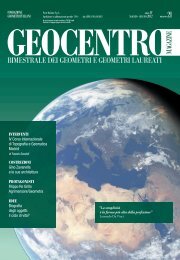Geocentro Magazine - Fondazione Geometri
Geocentro Magazine - Fondazione Geometri
Geocentro Magazine - Fondazione Geometri
You also want an ePaper? Increase the reach of your titles
YUMPU automatically turns print PDFs into web optimized ePapers that Google loves.
70<br />
ANNO II | n. 7 | GENNAIO - FEBBRAIO 2010<br />
Maire, ultimata nel 1755 alla scala 1:375000.<br />
Con la carta di padre Maire si afferma definitivamente<br />
in Italia il concetto di cartografia geometrica e viene<br />
tracciata la strada agli analoghi, gloriosi lavori che di lì<br />
a poco si sarebbero compiuti nel Regno di Napoli, con<br />
Giovanni Antonio Rizzi Zannoni (1736 - 1814), nel<br />
Ducato di Milano, con gli scienziati dell’Osservatorio<br />
astronomico di Brera, ed in tante altre parti della penisola,<br />
fino all’ultima, grande realizzazione ad opera di padre<br />
Giovanni Inghirami (1779 - 1851) per la Carta <strong>Geometri</strong>ca<br />
della Toscana, che chiude la lunga serie delle realizzazioni<br />
cartografiche ufficiali preunitarie, facendo sempre del dato<br />
posizionale l’elemento più qualificante e cogente della<br />
rappresentazione cartografica, anche a scapito dello stesso<br />
linguaggio cartografico, sempre più sintetico, essenziale,<br />
schematico, al punto di divenire talvolta criptico ed<br />
impenetrabile finanche ai tecnici.<br />
Considerazione quest’ultima che può far concludere queste<br />
brevi note non con un’affermazione di circostanza, ma con<br />
una doverosa domanda:<br />
Fino a che punto è ancora oggi necessario, alla luce delle<br />
innumerevoli potenzialità offerte dalle nuove tecnologie<br />
informatiche, sacrificare sull’altare euclideo quel valore<br />
aggiunto che aveva ispirato gli allestimenti cartografici<br />
del passato e che ancora oggi ci fa rimanere senza parola<br />
davanti ad opere come quelle di Leonardo da Vinci o di<br />
Giambattista Nolli?<br />
Giovanni Inghirami, Carta <strong>Geometri</strong>ca<br />
della Toscana, 1830<br />
Giovanni Inghirami, <strong>Geometri</strong>c Map of<br />
Tuscany, 1830<br />
of Italian geodetic cartography fixes in Italy the first geodetic<br />
reference system and the realisation of the Nuova Carta<br />
Geografica dello Stato Ecclesiastico […] by Christopher<br />
Maire, published in 1755 on a 1:375000 scale.<br />
In Italy, with Father Maire’s map, the idea of a geometrical<br />
cartography gained a hold once and for all. That opened the<br />
way to similar and successful works that would be undertaken<br />
in the following years in the Kingdom of Naples by Giovanni<br />
Antonio Rizzi Zannoni (1736-1814), in the Dukedom of<br />
Milan by the scientists of the Astronomic Observatory in<br />
Brera, and in many other parts of the country. The last great<br />
accomplishment was the work of Father Giovanni Inghirami<br />
(1779-1851): the Carta <strong>Geometri</strong>ca della Toscana marks the<br />
end of the Italian pre-unification cartography. The positional<br />
data was more and more at the core of any cartographic<br />
representation, even to the detriment of the cartographic<br />
language itself (always more and more synthetic, essential,<br />
schematic to the point of becoming incomprehensible even for<br />
the technicians).<br />
This last remark can lead us to a conclusion with a right and<br />
proper question:<br />
Nowadays, considering the possibilities offered by the new<br />
information technologies, is it necessary to sacrifice on the<br />
Euclidean altar the potentialities opened by the maps of<br />
the past centuries, that are still able to let us speechless in<br />
front of masterpieces such as those by Leonardo da Vinci or<br />
Giambattista Nolli?






